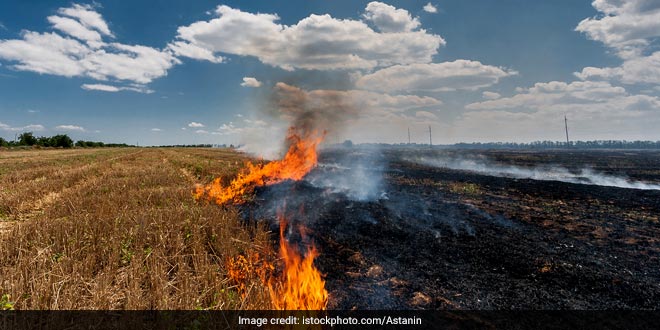New Delhi: Punjab has recorded a 25 per cent increase in stubble burning incidents as compared to 2018, which the state government attributed to early harvesting of paddy crop this year. The number of farm fires in Haryana, however, has decreased by 10 per cent as compared to last year, despite the “moderate implementation of the ban on stubble burning due to elections”, according to officials. Till October 20, Punjab recorded 2,482 cases of stubble burning against 1,980 last year, an increase of around 25 per cent. A significant rise in stubble burning was recorded on October 19 and 20.
Also Read: Punjab Farmers To Get 28,000 Agro-Machines From The State Government To Tackle Stubble Burning
While 446 cases were reported on October 19, the number on October 20 touched the 500 mark. Only 64 cases were recorded on October 18 when a western disturbance caused rainfall in parts of Punjab. According to Punjab Pollution Control Board data, Tarn Taran, Amritsar and Patiala have recorded 450, 417 and 249 cases, respectively.
Haryana witnessed 2,048 farm fires as compared to 2,283 last year. Karnal, Kaithal and Kurukshetra have reported 543, 503 and 422 incidents of stubble burning, respectively, till October 20.
The period between October 15 and November 15 is considered critical as maximum number of stubble burning incidents take place in this span in Punjab and adjoining states, which is one of the main reasons for an alarming spike in pollution in Delhi-NCR. Despite a ban on stubble burning in Punjab and Haryana, farmers continue to defy it amid lack of financial incentives. State governments are providing 50 to 80 per cent subsidy to farmers and cooperative societies to buy modern farm equipment for in-situ management of paddy straw, and running a massive awareness campaign against stubble burning.
A Punjab government official, who did not wish to be named, said the high court’s September 19 order staying the recovery of fine from farmers found violating the ban on stubble burning has subdued the effect of challans. “Not one challan has been issued this year.”
However, Karunesh Garg, member secretary of the Punjab Pollution Control Board, said the court had only stalled the recovery of fine imposed in previous years and that challans will be issued this time too. “The single bench referred the matter to the court of the chief justice who has categorically said that stubble burning is banned. The government has also made it clear and issued strict directions to curb farm fires,” he said.
We have identified the erring farmers and the process of issuing challans has been set in motion, Mr Garg said.
Another official on condition of anonymity said that bypolls in some parts of Punjab “prevented the government from issuing challans this year”. Secretary (Agriculture) K S Pannu said the number of farm fires seems large because of early harvesting of paddy crops.
Also Read: Stubble Burning Not Going To Stop On Its Own, Consider Granting Subsidy To Farmers: SC
This year, the harvesting began around a week earlier as compared to the last year. That’s the reason the number of farm fires looks big. I am sure the cumulative figure at the end of the harvesting period will be much smaller, he said.
The Centre and the state government have made serious interventions, provided farm equipment and undertaken massive awareness drives to prevent stubble burning. If not this year, the problem will be completely resolved in the next two years, Mr Pannu said. Haryana Pollution Control Board Member Secretary S Narayanan said 102 challans have been issued against farmers for violating the ban on stubble burning, but the recovery of fine has been put on hold following the high court order.
“The number of farm fires has gone down considerably, despite the harvesting season starting early and the official machinery being busy in elections,” he said. The Delhi government has repeatedly attributed the spike in pollution in winter to rampant stubble burning in neighbouring states. “Air quality in Delhi has been good or moderate for the last 7-8 months, but they (pollution levels) have starkly gone up now. Clearly, the sudden spike in pollution is a result of smoke coming from outside,” Delhi Chief Minister Arvind Kejriwal had said earlier.
The Delhi government has also tied up with Washington University and set up a center near India Gate to collect data with the help of which it will be able to tell the degree of air pollution due to specific sources from April next year.






























